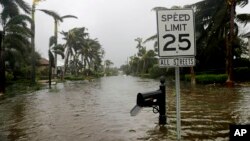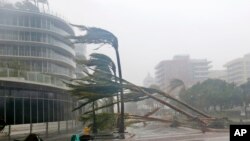Hurricane Irma weakened into a tropical storm Monday as it moved over northern Florida and into southern Georgia, even as its torrential rains and dangerous storm surges remained a threat to produce coastal flooding.
The National Hurricane Center warned that swells generated by Irma along the southeastern U.S. coast could still cause "life-threatening surf and rip current conditions."
In addition, the hurricane center says tornadoes are possible across northeastern Florida, southeastern Georgia and South Carolina through Monday night.
By Monday, Irma's sustained winds diminished to 110 kilometers an hour, the hurricane center said, but tropical storm force gales extended over a wide region, up to 665 kilometers outward from the Irma's center.
Satellite images:
Nearly 6 million without power
Much of Florida began to assess the damage left in the hurricane's aftermath. There was significant flooding in many cities and towns bordering the peninsula state's Gulf of Mexico shoreline, as well as in Jacksonville on the east coast along the Atlantic. Nearly 6 million people were left without power throughout the state.
Before hitting the U.S., Irma created a path of destruction through the Caribbean, devastating islands that depend on tourism as the keystone of their economies.
Meanwhile, weather forecasters are keeping an eye on Hurricane Jose, now with maximum sustained winds of 165 kilometers per hour. Jose is expected to gradually weaken as it travels in a near-circular pattern in the Atlantic through the middle of the week, posing no immediate threat to populated areas.
Irma devastated parts of Florida, the third most populous U.S. state, although early reports Monday seemed to indicate that damage left behind may not have been as much as originally feared.
The storm slammed into the Florida Keys early Sunday, when it was near its greatest strength. By evening it closed in on Tampa and St. Petersburg, the two largest cities around Tampa Bay, where a storm surge pushed waves of water deep into streets, yards and homes.
President Donald Trump Sunday declared Florida a major disaster area, a step that will release federal aid funds for storm victims more quickly.
More than 75,000 people checked into 400 emergency shelters statewide, but overall, only three storm-related deaths were reported in Florida through late Sunday. At least 25 people were killed since Irma clobbered the Caribbean late last week.
Caribbean hit hard
Prime Minister Gaston Browne of Antigua and Barbuda says 95 percent of Barbuda's buildings were either destroyed or severely damaged.
The U.S. territory of Puerto Rico suffered losses in its electricity network that left more than one million people without power. Authorities said it could take up to six months to rebuild the island's power grid.
Puerto Rico says it collaborated with the U.S. Department of Health and Human Services to evacuate more than 1,000 people, mainly U.S. citizens, from St. Thomas and St. Maarten.
The Pentagon deployed Navy ships, aircraft and hundreds of Marines to help with recovery efforts in Puerto Rico and the U.S. Virgin Islands. The U.S. Air Force flew evacuation flights to Puerto Rico and the U.S. Virgin Islands, and to the Dutch Caribbean island of St. Maarten, which also suffered severe damage.
The Netherlands' king, Willem-Alexander, is reported to be headed to St. Maarten to assist in recovery efforts, and French President Emmanuel Macron said he would be arriving aboard an Airbus plane packed with aid supplies.
France and the Netherlands share jurisdiction over the island that is home to St. Martin and St. Maarten. The smaller French island of St. Barthelemy, which is nearby, also was badly damaged.
VOA's Fern Robinson and Kenneth Schwartz contributed to this report.






